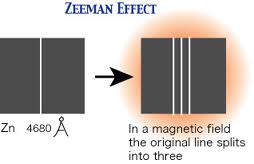 The splitting of a single spectral line into a group of closely spaced lines when the substance producing the single line is subjected to a uniform magnetic field. The effect was discovered in 1896 by the Dutch physicist Pieter Zeeman. In the so-called normal Zeeman effect, the spectral line corresponding to the original frequency of the light (in the absence of the magnetic field) appears with two other lines arranged symmetrically on either side of the original line. In the anomalous Zeeman effect (which is actually more common than the normal effect), several lines appear, forming a complex pattern.
The splitting of a single spectral line into a group of closely spaced lines when the substance producing the single line is subjected to a uniform magnetic field. The effect was discovered in 1896 by the Dutch physicist Pieter Zeeman. In the so-called normal Zeeman effect, the spectral line corresponding to the original frequency of the light (in the absence of the magnetic field) appears with two other lines arranged symmetrically on either side of the original line. In the anomalous Zeeman effect (which is actually more common than the normal effect), several lines appear, forming a complex pattern.
The normal Zeeman effect was successfully explained by H. A. Lorentz using the laws of classical physics (Zeeman and Lorentz shared the 1902 Nobel Prize in Physics). The anomalous Zeeman effect could not be explained using classical physics; the development of the quantum theory and the discovery of the electron’s intrinsic spin led to a satisfactory explanation. According to the quantum theory all spectral lines arise from transitions of electrons between different allowed energy levels within the atom, the frequency of the spectral line being proportional to the energy difference between the initial and final levels.
 Because of its intrinsic spin, the electron has a magnetic field associated with it. When an external magnetic field is applied, the electron’s magnetic field may assume only certain alignments. Slight differences in energy are associated with these different orientations, so that what was once a single energy level becomes three or more. Practical applications based on the Zeeman effect include spectral analysis and measurement of magnetic field strength. Since the separation of the components of the spectral line is proportional to the field strength, the Zeeman effect is particularly useful where the magnetic field cannot be measured by more direct methods.
Because of its intrinsic spin, the electron has a magnetic field associated with it. When an external magnetic field is applied, the electron’s magnetic field may assume only certain alignments. Slight differences in energy are associated with these different orientations, so that what was once a single energy level becomes three or more. Practical applications based on the Zeeman effect include spectral analysis and measurement of magnetic field strength. Since the separation of the components of the spectral line is proportional to the field strength, the Zeeman effect is particularly useful where the magnetic field cannot be measured by more direct methods.
History
 Zeeman, Pieter (1865-1943)
Zeeman, Pieter (1865-1943)
Dutch physicist who observed that an intense magnetic field would split single spectral lines into three components, an observation known as the Zeeman effect. Zeeman shared the 1902 Nobel Prize in physics with his teacher Lorentz for his discovery. Pieter Zeeman was born on May 25, 1865, in Zonnemaire, the Netherlands. His father was a Lutheran minister named Catharinus Farandinus Zeeman and his mothers name was Wilhelmina Worst. It was his mother who attended to his elementary education. He attended secondary school in Zierikzee, a town a few miles from his home.
He had a strong desire to attend University, for which he had to study the classical languages. And after a couple of years he finally entered the University of Leyden in 1885. Zeeman was a student of Hendrik Lorentz at the University of Leyden. He began lecturing at the University Leyden in 1890. In 1896, at the request of Lorentz, he began investigating the effect of magnetic fields on a light source and discovered what is now known as the Zeeman effect. This discovery proved Lorentz theory of electromagnetic radiation.






























